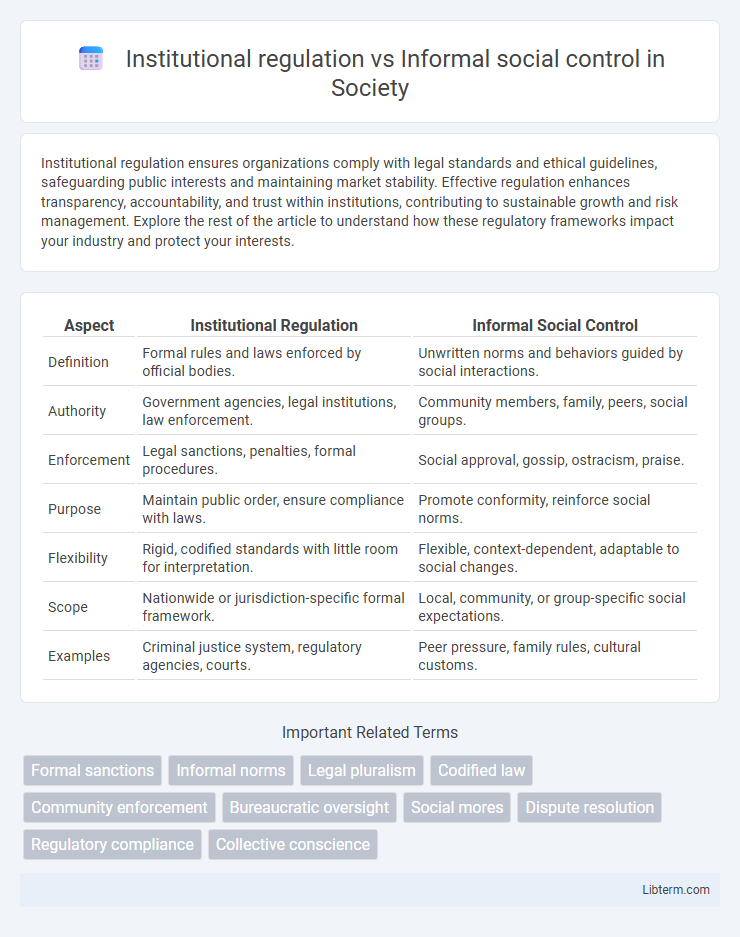Institutional regulation ensures organizations comply with legal standards and ethical guidelines, safeguarding public interests and maintaining market stability. Effective regulation enhances transparency, accountability, and trust within institutions, contributing to sustainable growth and risk management. Explore the rest of the article to understand how these regulatory frameworks impact your industry and protect your interests.
Table of Comparison
| Aspect | Institutional Regulation | Informal Social Control |
|---|---|---|
| Definition | Formal rules and laws enforced by official bodies. | Unwritten norms and behaviors guided by social interactions. |
| Authority | Government agencies, legal institutions, law enforcement. | Community members, family, peers, social groups. |
| Enforcement | Legal sanctions, penalties, formal procedures. | Social approval, gossip, ostracism, praise. |
| Purpose | Maintain public order, ensure compliance with laws. | Promote conformity, reinforce social norms. |
| Flexibility | Rigid, codified standards with little room for interpretation. | Flexible, context-dependent, adaptable to social changes. |
| Scope | Nationwide or jurisdiction-specific formal framework. | Local, community, or group-specific social expectations. |
| Examples | Criminal justice system, regulatory agencies, courts. | Peer pressure, family rules, cultural customs. |
Defining Institutional Regulation
Institutional regulation refers to the formal rules, laws, and policies established by governmental or organizational bodies to maintain order and guide behavior within a society. These regulations are codified, systematically enforced through official agencies, and carry legal consequences for non-compliance. Unlike informal social control, which relies on societal norms and peer pressure, institutional regulation operates through structured authority and documented procedures.
Exploring Informal Social Control
Informal social control operates through unwritten rules, social norms, and community enforcement mechanisms that influence behavior without formal legal authority. It relies on peer pressure, family expectations, and social networks to maintain order and discourage deviance within communities. Exploring informal social control reveals its critical role in fostering social cohesion and reducing reliance on institutional regulations such as laws and policing.
Historical Evolution of Social Control Mechanisms
Institutional regulation has evolved through formal laws, policies, and government agencies designed to maintain order and enforce compliance, tracing back to early legal codes like Hammurabi's Code and Roman law. Informal social control, rooted in community norms, traditions, and socialization processes, predates formal institutions and relies on family, peer pressure, and cultural customs to guide behavior. Over time, the historical evolution of social control mechanisms reflects a shift from decentralized, community-based regulation toward centralized, codified legal systems alongside persistent informal practices shaping social norms.
Key Differences Between Institutional Regulation and Informal Social Control
Institutional regulation involves formal rules and laws established by authorized bodies to govern behavior and ensure compliance, often enforced through legal penalties and official sanctions. Informal social control relies on societal norms, customs, and unwritten rules maintained by community members, using mechanisms like peer pressure, social approval, and ostracism to influence behavior. The key differences lie in their sources of authority--formal institutions versus community consensus--and methods of enforcement--legal systems versus social influence.
Examples of Institutional Regulation in Practice
Institutional regulation is exemplified by law enforcement agencies enforcing traffic laws, public health departments mandating vaccinations, and educational institutions implementing standardized testing protocols. These formal mechanisms establish clear rules and consequences, ensuring compliance through structured authority and legal frameworks. Such examples highlight how institutional regulation maintains societal order by codifying norms and applying systematic penalties for violations.
Forms and Methods of Informal Social Control
Informal social control manifests through social norms, peer pressure, gossip, and community expectations that guide individual behavior without formal sanctions. Methods include socialization, ridicule, ostracism, and moral persuasion, which reinforce conformity and maintain social order within groups. These practices operate independently of formal institutions like law enforcement or regulatory bodies, emphasizing relational and cultural mechanisms rooted in everyday interactions.
Impact on Social Order and Cohesion
Institutional regulation, implemented through formal laws and official agencies such as police and courts, establishes clear, consistent rules that maintain social order and resolve conflicts systematically. Informal social control relies on norms, values, and community interactions, fostering social cohesion by encouraging conformity through peer pressure, family influence, and cultural traditions. Both mechanisms complement each other; institutional regulation provides structure and deterrence, while informal social control strengthens social bonds and internalizes acceptable behavior within communities.
Strengths and Limitations of Each Approach
Institutional regulation provides formal mechanisms through laws and policies, ensuring consistency and enforceability in maintaining social order, but it can be rigid and slow to adapt to cultural changes. Informal social control relies on community norms and social interactions, fostering flexibility and immediate responses to behavior, though it risks inconsistency and potential bias. Balancing institutional regulation with informal social control enhances social harmony by combining structured authority with grassroots influence.
Interactions and Overlaps Between Formal and Informal Controls
Institutional regulation relies on formal laws, policies, and enforcement agencies, whereas informal social control emerges from community norms, peer pressure, and cultural expectations. Interactions between these systems occur when formal authorities recognize the influence of social norms or when informal groups support or resist institutional rules. Overlaps arise as institutions may adapt regulations to local customs, while informal control can enforce behavior consistent with formal laws, creating a dynamic interplay in governance and social order.
Future Trends in Social Regulation
Future trends in social regulation reveal a shift towards integrating institutional regulation with informal social control mechanisms to enhance community resilience. Advances in technology and data analytics enable more adaptive and real-time monitoring systems within formal institutions, while social media platforms amplify informal social control by fostering peer accountability and collective behavior norms. This convergence supports a hybrid regulatory environment where transparency, responsiveness, and participatory governance become pivotal in managing social order.
Institutional regulation Infographic

 libterm.com
libterm.com